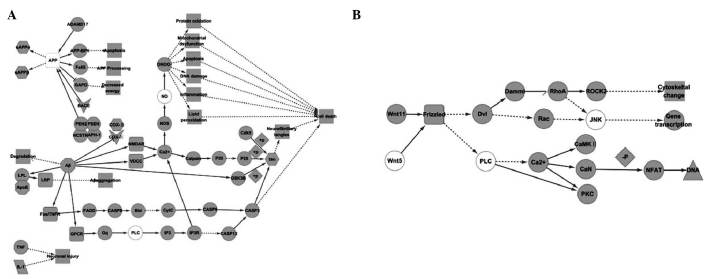Figure 2.
Kyoto Encyclopedia of Genes and Genomes pathway created using ‘Alzheimer’ as a key word. (A) Molecular map describing the responses triggered in the Alzheimer’s disease pathway. (B) Molecular map describing responses triggered in the WNT signaling pathway. Activation is reflected as a straight arrow and inhibition is reflected as an inverse ‘T’ shape. Indirect activation is reflected as a dotted arrow and indirect inhibition is reflected as a dotted inverted ‘T’ shape. Dissociation is reflected as equal lines and a missing interaction is reflected as a half arrow. The round-edged rectangle represents a membrane receptor and diamond shapes represent phosphorylation. The ‘V’ shape represents similarities with factors in Table II. The hexagon represents factors found in Fig. 1B, the ellipse with white color represents factors found in Fig. 1C and the octagon represents factors found in both Fig. 1B and C. Round-edged rectangles with white color indicate that both membrane receptor and be found in Fig. 1C and dotted round-edged rectangles indicated that both membrane receptor and be found in Table II. White dotted round-edged rectangles indicate that both membrane receptor and is found in Fig. 1B. Overlapping shapes represent a complex.

